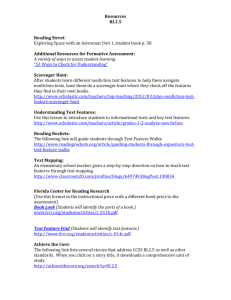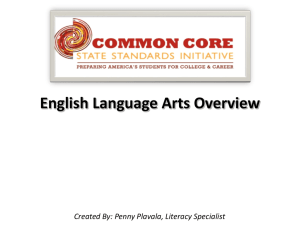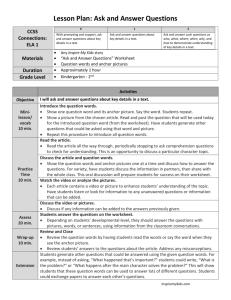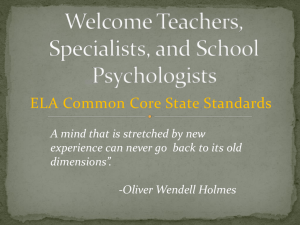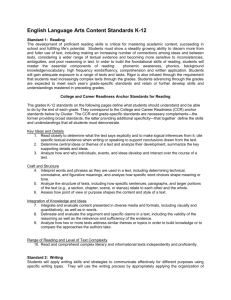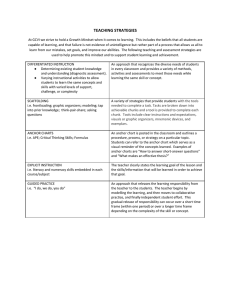English/Language Arts ● Unpacked Content
advertisement
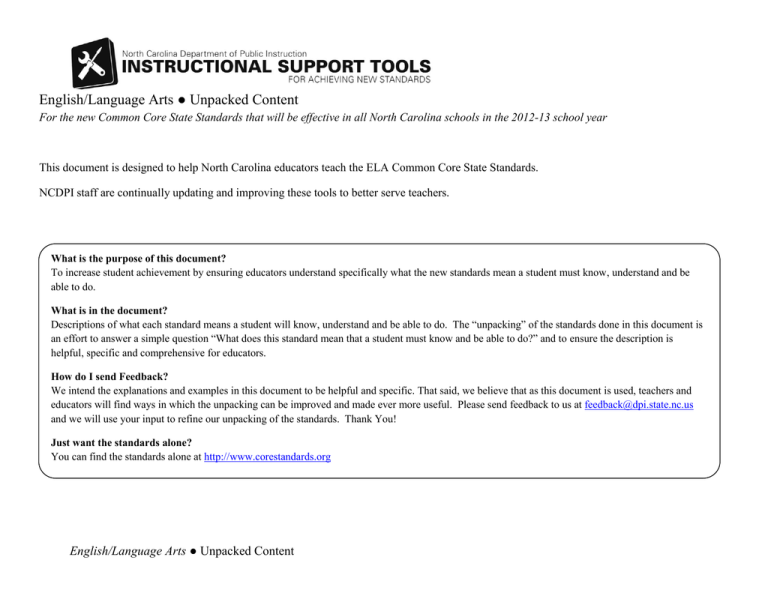
English/Language Arts ● Unpacked Content For the new Common Core State Standards that will be effective in all North Carolina schools in the 2012-13 school year This document is designed to help North Carolina educators teach the ELA Common Core State Standards. NCDPI staff are continually updating and improving these tools to better serve teachers. What is the purpose of this document? To increase student achievement by ensuring educators understand specifically what the new standards mean a student must know, understand and be able to do. What is in the document? Descriptions of what each standard means a student will know, understand and be able to do. The “unpacking” of the standards done in this document is an effort to answer a simple question “What does this standard mean that a student must know and be able to do?” and to ensure the description is helpful, specific and comprehensive for educators. How do I send Feedback? We intend the explanations and examples in this document to be helpful and specific. That said, we believe that as this document is used, teachers and educators will find ways in which the unpacking can be improved and made ever more useful. Please send feedback to us at feedback@dpi.state.nc.us and we will use your input to refine our unpacking of the standards. Thank You! Just want the standards alone? You can find the standards alone at http://www.corestandards.org English/Language Arts ● Unpacked Content ENGLISH LANGUAGE ARTS COMMON CORE STATE STANDARDS GRADE 1 CCR ANCHOR STANDARD College and Career Readiness Anchor Standards for Reading 1. Read closely to determine what the text says explicitly and to make logical inferences from it; cite specific textual evidence when writing or speaking to support conclusions drawn from the text. 2. Determine central ideas or themes of a text and analyze their development; summarize the key supporting details and ideas. 3. Analyze how and why individuals, events, and ideas develop and interact over the course of a text. CCSS STANDARD Reading Literature Key Ideas and Details 1. Ask and answer questions about key details in a text. 2. Retell stories, including key details, and demonstrate understanding of their central message or lesson. 3. Describe characters, settings, and major events in a story, using key details. UNPACKING First grade students continue to build on the skill of asking and answering questions about key details in a text. At this level, students use key details to retell stories in their own words, reveal an understanding about the central message of the text, and tell about the story elements. Use questions and prompts such as: Can you tell me what happened in the story at the beginning? What happened after that? What happened at the end of the story? Can you tell me where the story took place? Can you tell me the important things that happened in the story? Who are the characters in the story? What do you know about them? 2 ENGLISH LANGUAGE ARTS COMMON CORE STATE STANDARDS GRADE 1 CCR Anchor Standard College and Career Readiness Anchor Standards for Reading 4. Interpret words and phrases as they are used in a text, including determining technical, connotative, and figurative meanings, and analyze how specific word choices shape meaning or tone. 5. Analyze the structure of texts, including how specific sentences, paragraphs, and larger portions of the text (e.g., a section, chapter, scene, or stanza) relate to each other and the whole. 6. Assess how point of view or purpose shapes the content and style of a text. CCSS Standard Reading Literature Craft and Structure 4. Identify words and phrases in stories or poems that suggest feelings or appeal to the senses. 5. Explain major differences between books that tell stories and books that give information, drawing on a wide reading of a range of text types. 6. Identify who is telling the story at various points in a text. Unpacking First grade students begin to look at how words are used in a text by naming words and phrases that contribute to the feeling of the poem or story. They should understand the difference between books that tell stories and books that provide information. First grade students should be able to name who is telling the story. Use questions and prompts such as: Can you find the feeling words in this poem/story? Is this book an informational book or a story book? What in the text leads you to that answer? Who is telling the story in this part of the book? 3 ENGLISH LANGUAGE ARTS COMMON CORE STATE STANDARDS GRADE 1 CCR Anchor Standard College and Career Readiness Anchor Standards for Reading 7. Integrate and evaluate content presented in diverse media and formats, including visually and quantitatively, as well as in words.1 8. Delineate and evaluate the argument and specific claims in a text, including the validity of the reasoning as well as the relevance and sufficiency of the evidence. 9. Analyze how two or more texts address similar themes or topics in order to build knowledge or to compare the approaches the authors take. CCSS Standard Reading Literature Integration of Knowledge and Ideas 7. Use illustrations and details in a story to describe its characters, setting, or events. 8. (Not applicable to literature) 9. Compare and contrast the adventures and experiences of characters in stories. Unpacking Students are required to use pictures and details in a story to tell about characters, setting, and events. They continue to build on character development by looking at similarities and differences in characters‟ experiences in stories. Use questions and prompts such as: Can you find an illustration or part that shows the main character? Can you find an illustration or part that shows the setting? Can you find an illustration or part that shows the problem in the story? What is the same about the characters in the two stories? What is different? What happened to the characters that is the same? What is different? Did the characters solve the problem in different ways? If so, how? 4 ENGLISH LANGUAGE ARTS COMMON CORE STATE STANDARDS GRADE 1 CCR Anchor Standard CCSS Standard Unpacking College and Career Readiness Anchor Reading Literature Standards for Reading Range of Reading and Level of Text Complexity 10. Read and comprehend complex literary 10. With prompting and support, read With assistance, students are required to and informational texts independently and prose and poetry of appropriate complexity read prose and poetry at the text for grade 1. complexity for grade 1. proficiently. Prose is writing that is not poetry. “The Reading standards place equal emphasis on the sophistication of what students read and the skill with which they read. Standard 10 defines a grade-by-grade ‘staircase ’ of increasing text complexity that rises from beginning reading to the college and career readiness level. Whatever they are reading, students must also show a steadily growing ability to discern more from and make fuller use of text including making an increasing number of connections among ideas and between texts, considering a wider range of textual evidence, and becoming more sensitive to inconsistencies, ambiguities, and poor reasoning in texts.” “Students also acquire the habits of reading independently and closely, which are essential to their future success.” Students should encounter appropriately 5 ENGLISH LANGUAGE ARTS COMMON CORE STATE STANDARDS GRADE 1 complex texts at each grade level in order to develop the mature language skills and the conceptual knowledge needed for success in school and life. Effective scaffolding should allow the reader to encounter the text with minimal clarifications. It should not replace the text by translating its contents for students. 6 ENGLISH LANGUAGE ARTS COMMON CORE STATE STANDARDS GRADE 1 CCR Anchor Standard College and Career Readiness Anchor Standards for Reading 1. Read closely to determine what the text says explicitly and to make logical inferences from it; cite specific textual evidence when writing or speaking to support conclusions drawn from the text. 2. Determine central ideas or themes of a text and analyze their development; summarize the key supporting details and ideas. 3. Analyze how and why individuals, events, and ideas develop and interact over the course of a text. CCSS Standard Reading Informational Text Key Ideas and Details 1. Ask and answer questions about key details in a text. 2. Identify the main topic and retell key details of a text. 3. Describe the connection between two individuals, events, ideas, or pieces of information in a text. Unpacking First grade students continue to build on the skill of asking and answering questions about key details in a text. At this level, students should be able to identify the main idea and retell the key details in their own words. They should also be able to tell how two individuals, events, ideas or pieces of information are linked together. Use questions and prompts such as: Think about what you read and create your own question about an important idea in this text. What is the main idea of this text? Can you find one of the important ideas in this text? Can you find another important idea? Can you tell me how these two events are linked together? (cause/effect, time order) 7 ENGLISH LANGUAGE ARTS COMMON CORE STATE STANDARDS GRADE 1 CCR Anchor Standard College and Career Readiness Anchor Standards for Reading 4. Interpret words and phrases as they are used in a text, including determining technical, connotative, and figurative meanings, and analyze how specific word choices shape meaning or tone. 5. Analyze the structure of texts, including how specific sentences, paragraphs, and larger portions of the text (e.g., a section, chapter, scene, or stanza) relate to each other and the whole. 6. Assess how point of view or purpose shapes the content and style of a text. CCSS Standard Reading Informational Text Unpacking Craft and Structure 4. Ask and answer questions to help determine or clarify the meaning of words and phrases in a text. First grade students should use the skill of asking and answering questions to help them understand what words and phrases mean in the text. Students at this level should understand how to use text features 5. Know and use various text features (e.g., to help them understand the text and be able to tell the difference between what headings, tables of contents, glossaries, electronic menus, icons) to locate key facts information can be gained by examining the pictures and what can be gained from or information in a text. examining the words. Use questions and prompts such as: 6. Distinguish between information provided by pictures or other illustrations What features in the text help you find important information? and information provided by the words in a text. How do the headings help you understand the text? What does the table of contents help you to know? Can you tell me what is different about what the picture shows and what the words say about…? 8 ENGLISH LANGUAGE ARTS COMMON CORE STATE STANDARDS GRADE 1 CCR Anchor Standard College and Career Readiness Anchor Standards for Reading 7. Integrate and evaluate content presented in diverse media and formats, including visually and quantitatively, as well as in words.1 8. Delineate and evaluate the argument and specific claims in a text, including the validity of the reasoning as well as the relevance and sufficiency of the evidence. 9. Analyze how two or more texts address similar themes or topics in order to build knowledge or to compare the approaches the authors take. CCSS Standard Reading Informational Text Integration of Knowledge and Ideas 7. Use the illustrations and details in a text to describe its key ideas. 8. Identify the reasons an author gives to support points in a text. 9. Identify basic similarities in and differences between two texts on the same topic (e.g., in illustrations, descriptions, or procedures). Unpacking Students will understand how illustrations help explain the text. At this level, students should also develop the ability to recognize the author‟s reasoning by finding support within the text. Students will look for similarities and differences in two texts that share the same main idea. Use questions and prompts such as: Can you tell how the author uses this chart to help you understand? What does this chart add to your thinking about what you read? Can you find the reason why the author thinks that…? Can you find the reason why the author believes…? Look at these two texts about the same topic. How are they the same? How are they different? 9 ENGLISH LANGUAGE ARTS COMMON CORE STATE STANDARDS GRADE 1 CCR Anchor Standard CCSS Standard Unpacking College and Career Readiness Anchor Reading Informational Text Standards for Reading Range of Reading and Level of Text Complexity 10. Read and comprehend complex literary 10. With prompting and support, read With assistance, students are required to and informational texts independently and informational texts appropriately complex read informational text at the appropriate complexity for grade 1. proficiently. for grade 1. “The Reading standards place equal emphasis on the sophistication of what students read and the skill with which they read. Standard 10 defines a grade-by-grade ‘staircase ’ of increasing text complexity that rises from beginning reading to the college and career readiness level. Whatever they are reading, students must also show a steadily growing ability to discern more from and make fuller use of text including making an increasing number of connections among ideas and between texts, considering a wider range of textual evidence, and becoming more sensitive to inconsistencies, ambiguities, and poor reasoning in texts.” “Students also acquire the habits of reading independently and closely, which are essential to their future success.” Students should encounter appropriately complex texts at each grade level in order to develop the mature language skills and 10 ENGLISH LANGUAGE ARTS COMMON CORE STATE STANDARDS GRADE 1 the conceptual knowledge needed for success in school and life. Effective scaffolding should allow the reader to encounter the text with minimal clarifications. It should not replace the text by translating its contents for students. 11 ENGLISH LANGUAGE ARTS COMMON CORE STATE STANDARDS GRADE 1 CCR Anchor Standard There are no Anchor Standards for Reading Foundational Skills CCSS Standard Reading Foundational Skills Print Concepts 1. Demonstrate understanding of the organization and basic features of print. a. Recognize the distinguishing features of a sentence (e.g., first word, capitalization, ending punctuation). Unpacking Students will understand how a sentence is organized. Use questions and prompts such as: Show me the first word of the sentence. Where does the period (question mark, etc.) go? Show me the capital letter. How does a sentence begin? What goes at the end of a sentence? 12 ENGLISH LANGUAGE ARTS COMMON CORE STATE STANDARDS GRADE 1 CCR Anchor Standard There are no Anchor Standards for Reading Foundational Skills CCSS Standard Reading Foundational Skills Phonological Awareness 2. Demonstrate understanding of spoken words, syllables, and sounds (phonemes). a. Distinguish long from short vowel sounds in spoken single-syllable words. b. Orally produce single-syllable words by blending sounds (phonemes), including consonant blends. c. Isolate and pronounce initial, medial vowel, and final sounds (phonemes) in spoken single-syllable words. d. Segment spoken single-syllable words into their complete sequence of individual sounds (phonemes). Unpacking Use questions and prompts such as: Does this word have a long or short vowel sound? Say each sound you hear in this word slowly. What do you hear at the beginning of this word? What do you hear next? At the end? 13 ENGLISH LANGUAGE ARTS COMMON CORE STATE STANDARDS GRADE 1 CCR Anchor Standard There are no Anchor Standards for Reading Foundational Skills CCSS Standard Reading Foundational Skills Phonics and Word Recognition 3. Know and apply grade-level phonics and word analysis skills in decoding words. a. Know the spelling-sound correspondences for common consonant digraphs (two letters that represent one sound). b. Decode regularly spelled one-syllable words. c. Know final -e and common vowel team conventions for representing long vowel sounds. d. Use knowledge that every syllable must have a vowel sound to determine the number of syllables in a printed word. e. Decode two-syllable words following basic patterns by breaking the words into syllables. f. Read words with inflectional endings. g. Recognize and read grade-appropriate irregularly spelled words. Unpacking Students continue learning specific strategies for decoding words in texts. Learning suffixes and vowel patterns enhances decoding, spelling ability, and vocabulary development. Use questions and prompts such as: Does that sound right? Does that look right? Does that make sense? Look at the word, does it look like…? You said…does it look like…? What do these two letters sound like together (sh, th, ch) in this word? Can you clap the syllables in this word? What does this final e tell you about this word? Look at the beginning of that word, can you get it started? 14 ENGLISH LANGUAGE ARTS COMMON CORE STATE STANDARDS GRADE 1 CCR Anchor Standard There are no Anchor Standards for Reading Foundational Skills CCSS Standard Reading Foundational Skills Fluency 4. Read with sufficient accuracy and fluency to support comprehension. a. Read grade-level text with purpose and understanding. b. Read grade-level text orally with accuracy, appropriate rate, and expression. c. Use context to confirm or self-correct word recognition and understanding, rereading as necessary. Unpacking Fluency helps the reader process language for meaning and enjoyment. Fluent readers are able to focus attention on the meaning of the text. Readers at this stage benefit from opportunities to read texts multiple times at an independent level. Use questions and prompts such as: Make your reading sound like the characters are talking. Make your voice sound like the words are together. Make your voice go up when you see the question mark at the end. Make your voice go down when you see the period at the end. Go back and reread when it doesn‟t sound or look like you think it should. 15 ENGLISH LANGUAGE ARTS COMMON CORE STATE STANDARDS GRADE 1 CCR Anchor Standard College and Career Readiness Anchor Standards for Writing 1. Write arguments to support claims in an analysis of substantive topics or texts, using valid reasoning and relevant and sufficient evidence. 2. Write informative/explanatory texts to examine and convey complex ideas and information clearly and accurately through the effective selection, organization, and analysis of content. 3. Write narratives to develop real or imagined experiences or events using effective technique, well-chosen details, and well-structured event sequences. CCSS Standard Writing Text Types and Purposes 1. Write opinion pieces in which they introduce the topic or name the book they are writing about, state an opinion, supply a reason for the opinion, and provide some sense of closure. 2. Write informative/explanatory texts in which they name a topic, supply some facts about the topic, and provide some sense of closure. 3. Write narratives in which they recount two or more appropriately sequenced events, include some details regarding what happened, use temporal words to signal event order, and provide some sense of closure. Unpacking First grade students should be able to express their opinion and demonstrate the ability to share their opinion with others. In first grade, students write opinion pieces that clearly state their preferences and supply a reason for their thinking. In doing so, students need multiple opportunities to express opinions and develop writing behaviors. Students need to engage in behaviors (turn and talk, small group discussion, and emergent writing and speaking learning centers) that lead to the expression of ideas both verbally and in writing: Students will also need a purposeful focus on choicemaking throughout ELA. For example, in this grade, students are expected to be able to select a reason that supports their opinion and be able to share their thinking. First grade students are required to include both an introduction and a sense of closure or a closing statement in their writing. Students will need to build strategies for introducing concepts (such as beginning 16 ENGLISH LANGUAGE ARTS COMMON CORE STATE STANDARDS GRADE 1 with a fact or question) and concluding their thoughts (learning to write a summary statement) when writing. They will begin to use temporal words (now, when, then) to show order of events. 17 ENGLISH LANGUAGE ARTS COMMON CORE STATE STANDARDS GRADE 1 CCR Anchor Standard College and Career Readiness Anchor Standards for Writing 4. Produce clear and coherent writing in which the development, organization, and style are appropriate to task, purpose, and audience. 5. Develop and strengthen writing as needed by planning, revising, editing, rewriting, or trying a new approach. 6. Use technology, including the Internet, to produce and publish writing and to interact and collaborate with others. CCSS Standard Writing Unpacking Production and Distribution of Writing 4. (Begins in grade 3) With assistance from adults and peers, students should focus their writing on a topic and be able to respond to questions and suggestions. In order to do so, students 5. With guidance and support from adults, need to understand how to add descriptive words to their writing to strengthen their focus on a topic, respond to questions and piece. They also need to develop the ability suggestions from peers, and add details to to recognize spelling, grammar, and strengthen writing as needed. 6. With guidance and support from adults, punctuation errors and have strategies for use a variety of digital tools to produce and correcting these errors with assistance publish writing, including in collaboration (during conferences and peer editing). with peers. With assistance, students will use digital tools to publish their writing independently and in collaboration with peers (use of keyboarding and technology). At this grade level, students will need to be able to “log on” to programs, computer stations, and hand-held devices to engage with digital media. 18 ENGLISH LANGUAGE ARTS COMMON CORE STATE STANDARDS GRADE 1 CCR Anchor Standard College and Career Readiness Anchor Standards for Writing CCSS Standard Writing Research to Build and Present Knowledge 7. Conduct short as well as more sustained 7. Participate in shared research and research projects based on focused writing projects (e.g., explore a number of questions, demonstrating understanding of “how-to” books on a given topic and use the subject under investigation. them to write a sequence of instructions). 8. Gather relevant information from 8. With guidance and support from adults, multiple print and digital sources, assess recall information from experiences or the credibility and accuracy of each source, gather information from provided sources and integrate the information while to answer a question. avoiding plagiarism. 9. Draw evidence from literary or 9. (Begins in grade 4) informational texts to support analysis, reflection, and research. Unpacking First grade students are required to participate in shared research projects. Students will need to understand their role (job on the team) and how they will contribute (work they will do) to the project from beginning to end. Items, such as, task charts, check sheets, and graphic organizers will be helpful to students as they learn to work together. At this level, students are working with provided research. They need to know how to scan the information provided (words, pictures, digital sources) and/or recall from their own background knowledge the pieces they need to answer research questions and take notes. Students do this work with prompting and support. 19 ENGLISH LANGUAGE ARTS COMMON CORE STATE STANDARDS GRADE 1 CCR Anchor Standard College and Career Readiness Anchor Standards for Writing 10. Write routinely over extended time frames (time for research, reflection, and revision) and shorter time frames (a single sitting or a day or two) for a range of tasks, purposes, and audiences. CCSS Standard Writing Unpacking Range of Writing 10. (Begins in grade 3) 20 ENGLISH LANGUAGE ARTS COMMON CORE STATE STANDARDS GRADE 1 CCR Anchor Standard College and Career Readiness Anchor Standards for Speaking and Listening CCSS Standard Speaking and Listening Comprehension and Collaboration 1. Prepare for and participate effectively in 1. Participate in collaborative a range of conversations and collaborations conversations with diverse partners about with diverse partners, building on others‟ grade 1 topics and texts with peers and ideas and expressing their own clearly and adults in small and larger groups. persuasively. a. Follow agreed-upon rules for discussions (e.g., listening to others with care, speaking one at a time about the topics and texts under discussion). b. Build on others‟ talk in conversations by responding to the comments of others through multiple exchanges. c. Ask questions to clear up any confusion about the topics and texts under discussion. 2. Integrate and evaluate information 2. Ask and answer questions about key presented in diverse media and formats, details in a text read aloud or information including visually, quantitatively, and presented orally or through other media. orally. 3. Evaluate a speaker‟s point of view, 3. Ask and answer questions about what a reasoning, and use of evidence and speaker says in order to gather additional rhetoric. information or clarify something that is not understood. Unpacking Students in first grade will engage in conversations about grade-appropriate topics and texts. In order to do so, students will need ample opportunities to take part in a variety of rich, structured conversations. Students actively engage as part of a whole class, in small groups, and with a partner, sharing the roles of participant, leader, and observer. Students at this level should engage in collaborative conversations (such as book groups, literature circles, buddy reading), and develop skills in active (close) listening and group discussion (looking at the speaker, turn taking, linking ideas to the speakers‟ idea, sharing the floor, etc.). First grade students will also ask and answer questions about key details of a text read aloud or information presented in multiple formats. First grade students should also be able to listen carefully to a text read aloud and to recount or describe details about what they heard. Students need to ask questions and understand and answer questions asked of them, in order to clarify or gain more information. 21 ENGLISH LANGUAGE ARTS COMMON CORE STATE STANDARDS GRADE 1 CCR Anchor Standard College and Career Readiness Anchor Standards for Speaking and Listening 4. Present information, findings, and supporting evidence such that listeners can follow the line of reasoning and the organization, development, and style are appropriate to task, purpose, and audience. 5. Make strategic use of digital media and visual displays of data to express information and enhance understanding of presentations. 6. Adapt speech to a variety of contexts and communicative tasks, demonstrating command of formal English when indicated or appropriate. CCSS Standard Speaking and Listening Presentation of Knowledge and Ideas 4. Describe people, places, things, and events with relevant details, expressing ideas and feelings clearly. 5. Add drawings or other visual displays to descriptions when appropriate to clarify ideas, thoughts, and feelings. 6. Produce complete sentences when appropriate to task and situation. Unpacking First grade students should be able to report facts and relevant details about an experience. This should be done orally, with some detail, and with clarity of thought and emotions. They should be able to add visual displays to illuminate chosen facts or details. In order to do so, students will need multiple opportunities to present information to others and develop behaviors that will lead to the ability to add appropriate visual displays. Students will need to engage in behaviors (turn and talk, small group discussion, and listening and speaking learning centers) that lead to the expression of complete ideas both verbally and in writing. Students will also need a purposeful focus throughout ELA on choice-making. For example, first grade students need to be able to choose visual displays that add to and support their thinking about a topic. Students must be able to articulate their ideas in complete sentences when appropriate to the audience. 22 ENGLISH LANGUAGE ARTS COMMON CORE STATE STANDARDS GRADE 1 CCR Anchor Standard College and Career Readiness Anchor Standards for Language 1. Demonstrate command of the conventions of standard English grammar and usage when writing or speaking. CCSS Standard Language Conventions of Standard English 1. Demonstrate command of the conventions of standard English grammar and usage when writing or speaking. a. Print all upper- and lowercase letters. b. Use common, proper, and possessive nouns. c. Use singular and plural nouns with matching verbs in basic sentences (e.g., He hops; We hop). d. Use personal, possessive, and indefinite pronouns (e.g., I, me, my; they, them, their, anyone, everything). e. Use verbs to convey a sense of past, present, and future (e.g., Yesterday I walked home; Today I walk home; Tomorrow I will walk home). f. Use frequently occurring adjectives. g. Use frequently occurring conjunctions (e.g., and, but, or, so, because). h. Use determiners (e.g., articles, demonstratives). i. Use frequently occurring prepositions (e.g., during, beyond, toward). j. Produce and expand complete simple and compound declarative, interrogative, imperative, and exclamatory sentences in response to prompts. Unpacking An understanding of language is essential for effective communication. “The inclusion of Language standards in their own strand should not be taken as an indication that skills related to conventions, knowledge of language, and vocabulary are unimportant to reading, writing, speaking, listening, and viewing; indeed, they are inseparable from such contexts.” First grade students must have a command of the grammar and usage of spoken and written standard English. Standards that are related to conventions are appropriate to formal spoken English as they are to formal written English. At this level, emphasis expands to include verb tense, possessives, pronouns, adjectives, conjunctions, and more complex sentences. With conventions, students are becoming more adept at ending punctuation, expanding their understanding and usage of capitalization, and spelling unknown words phonetically. 23 ENGLISH LANGUAGE ARTS COMMON CORE STATE STANDARDS GRADE 1 2. Demonstrate command of the conventions of standard English capitalization, punctuation, and spelling when writing. 2. Demonstrate command of the conventions of standard English capitalization, punctuation, and spelling when writing. a. Capitalize dates and names of people. b. Use end punctuation for sentences. c. Use commas in dates and to separate single words in a series. d. Use conventional spelling for words with common spelling patterns and for frequently occurring irregular words. e. Spell untaught words phonetically, drawing on phonemic awareness and spelling conventions. 24 ENGLISH LANGUAGE ARTS COMMON CORE STATE STANDARDS GRADE 1 CCR Anchor Standard College and Career Readiness Anchor Standards for Language 3. Apply knowledge of language to understand how language functions in different contexts, to make effective choices for meaning or style, and to comprehend more fully when reading or listening. CCSS Standard Language Unpacking Knowledge of Language 3. (Begins in grade 2) 25 ENGLISH LANGUAGE ARTS COMMON CORE STATE STANDARDS GRADE 1 CCR Anchor Standard College and Career Readiness Anchor Standards for Language 4. Determine or clarify the meaning of unknown and multiple-meaning words and phrases by using context clues, analyzing meaningful word parts, and consulting general and specialized reference materials, as appropriate. 5. Demonstrate understanding of word relationships and nuances in word meanings. CCSS Standard Language Vocabulary Acquisition and Use 4. Determine or clarify the meaning of unknown and multiple-meaning words and phrases based on grade 1 reading and content, choosing flexibly from an array of strategies. a. Use sentence-level context as a clue to the meaning of a word or phrase. b. Use frequently occurring affixes as a clue to the meaning of a word. c. Identify frequently occurring root words (e.g., look) and their inflectional forms (e.g., looks, looked, looking). 5. With guidance and support from adults, demonstrate understanding of figurative language, word relationships and nuances in word meanings. a. Sort words into categories (e.g., colors, clothing) to gain a sense of the concepts the categories represent. b. Define words by category and by one or more key attributes (e.g., a duck is a bird that swims; a tiger is a large cat with stripes). c. Identify real-life connections between words and their use (e.g., note places at home that are cozy). d. Distinguish shades of meaning among verbs differing in manner (e.g., look, Unpacking As students at this level focus on word acquisition and use, the intent of the CCSS is to introduce grammatical knowledge in basic ways that will be relearned in more sophisticated contexts in the upper grades. The overall focus of language learning in regards to vocabulary acquisition is to guide students as they make purposeful language choices in writing and speaking, in order to communicate effectively in a wide range of print and digital texts. Students need to understand the diversity in standard English and the ways authors use formal and informal voice (dialects, registers) to craft their message for specific purposes. Students also need strategies for learning to make these kinds of choices for themselves as they write and speak in different contexts and for different purposes. 26 ENGLISH LANGUAGE ARTS COMMON CORE STATE STANDARDS GRADE 1 6. Acquire and use accurately a range of general academic and domain-specific words and phrases sufficient for reading, writing, speaking, and listening at the college and career readiness level; demonstrate independence in gathering vocabulary knowledge when encountering an unknown term important to comprehension or expression. peek, glance, stare, glare, scowl) and adjectives differing in intensity (e.g., large, gigantic) by defining or choosing them or by acting out the meanings. 6. Use words and phrases acquired through conversations, reading and being read to, and responding to texts, including using frequently occurring conjunctions to signal simple relationships (e.g., because). Learning words at this stage includes exploring different shades of the same verb (run/sprint), adjectives of differing intensity, and inflectional forms; understanding categories of common concepts/objects; and defining words by category. 27
